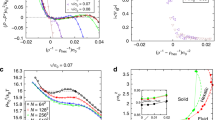Abstract
Using several theoretical tools\(\ldots \) (i) the nucleation theorem, (ii) an equivalent cavity, (iii) the reversible work of adding a cavity to an open hard sphere system, and (iv) the theory of “stability”... the authors estimated the density at which the hard sphere freezing transition occurs. No direct involvement of the equilibrium solid phase is involved. The reduced density \(\uppi a^3\rho _f/6\) (where a is the hard sphere diameter and \(\rho _f \) is the actual density at which freezing occurs) is found to be 0.4937 while the value obtained by computer simulation is 0.494. The agreement is good, but the new method still contains some approximation. However, the approximation is based on the idea that at a density just below \(\rho _f \) the fluid adopts a distorted structure resembling the solid, but different enough so that long-range order vanishes. Initial loss of stability may not be involved in every fluid–solid transition, but it may be an early step in the hard sphere and related systems.
Similar content being viewed by others
References
Bernal, J.D.: Geometry of the structure of monatomic liquids. Nature (London) 185, 68–70 (1960)
Bernal, J.D., Mason, J.: Packing of spheres: co-ordination of randomly packed spheres. Nature (London) 188, 910–911 (1960)
Scott, G.D.: Packing of spheres: packing of equal spheres. Nature (London) 188, 908–909 (1960)
Berryman, J.G.: Random close packing of hard spheres and disks. Phys. Rev. A 27(2), 1053–1061 (1983)
Speedy, R.J.: Accurate theory of the hard sphere fluid. J. Chem. Soc. Faraday Trans. 2(73), 714–721 (1977)
Kamien, R.D., Liu, A.J.: Why is random close packing reproducible? Phys. Rev. Lett. 99(15), 155501 (2007)
Rintoul, M.D., Torquato, S.: Metastability and crystallization in hard-sphere systems. Phys. Rev. Lett. 77(20), 4198–4201 (1998)
Reiss, H., Frisch, H.L., Lebowitz, J.L.: Statistical mechanics of rigid spheres. J. Chem. Phys. 31(2), 369–380 (1959)
Siderius, D.W., Corti, D.S.: On the use of multiple interpolation functions in scaled particle theory to improve the predictions of the properties of the hard-sphere fluid. J. Chem. Phys. 127(4), 144502 (2007)
Speedy, R.J., Reiss, H.: Cavities in the hard sphere fluid and crystal and the equation of state. Mol. Phys. 72(5), 999–1014 (1991)
Speedy, R.J., Reiss, H.: A computer simulation study of cavities in the hard disc fluid and crystal. Mol. Phys. 72(5), 1015–1033 (1991)
Bagchie, B., Cerjan, C., Rice, S.A.: Theoretical analysis of the achievement of random close packing of hard spheres and a conjecture on spinodal decomposition. Phys. Rev. B 28(11), 6411–6415 (1983)
Xu, X., Rice, S.A.: Maximally random jamming of one-component and binary hard-disk fluids in two dimensions. Phys. Rev. E 83(2), 021120 (2011)
Torquato, S.: Random Heterogeneous Materials. Microstructure and Macroscopic Properties. Springer, New York (2002)
Kashchiev, D.: Nucleation. Basic Theory with Applications. Butterworth-Heinemann, Oxford (2000)
Reiss, H.: Methods of Thermodynamics. Dover, New York (1997)
Hill, T.L.: Statistical Mechanics. Principles and Selected Applications. Dover, New York (1987)
Zandi, R., Reguera, D., Reiss, H.: Nucleation rates in a new phenomenological model. J. Phys. Chem. B 110(44), 22251–22260 (2006)
Debenedetti, P.G.: Metastable Liquids. Concepts and Principles. Princeton University Press, Princeton (1996)
Corti, D.S., Debenedetti, P.G.: Statistical mechanics of fluids under internal constraints: rigorous results for the one-dimensional hard rod fluid. Phys. Rev. E. 57(4), 4211–4226 (1998)
Kivelson, D., Reiss, H.: Metastable systems in thermodynamics: consequences, role of constraints. J. Phys. Chem. B 103(39), 8337–8343 (1999)
Bowles, R.K., Reguera, D., Djikaev, Y., Reiss, H.: A theorem for inhomogeneous systems: the generalization of the nucleation theorem. J. Chem. Phys. 115(4), 1853–1866 (2001); ibid 116(5), 2330–2330 (2002)
Kegel, W.K., Reiss, H., Lekkerkerker, H.N.W.: Freezing transition in very small systems of hard spheres. Phys. Rev. Lett. 83(25), 5298–5301 (1999)
Kegel, W.K.: Freezing of hard spheres in confinement. J. Chem. Phys. 115(14), 6538–6549 (2001)
Reiss, H., Ellerby, H.M., Manzanares, J.A.: Ornstein–Zernike-like equations in statistical geometry: stable and metastable systems. J. Phys. Chem. 100(14), 5970–5981 (1996)
Acknowledgments
Foremost, I (J.A.M.) wish to express my deepest gratitude and respect to the late Professor Howard Reiss, an extremely stimulating scientist and best friend who has been a preeminent reference all along my academic career. This paper is dedicated to Dr. R.J. Speedy who almost single handedly invented the elegant discipline of statistical geometry. Also, the authors are indebted to many colleagues for valuable discussions concerning the paper. These include Professors Jianzhong Wu of the University of California, Riverside; Raphael Levine of the Hebrew University of Jerusalem; Robert Scott, Thomas Mason, Charles Knobler, and William Gelbart of the University of California, Los Angeles; Richard Bowles of the University of Saskatchewan; and Salvatore Torquato of Princeton University.
Author information
Authors and Affiliations
Corresponding author
Additional information
Howard Reiss—Deceased.
Rights and permissions
About this article
Cite this article
Reiss, H., Manzanares, J.A. Statistical Thermodynamics of an “Open” Hard Sphere System on the Equilibrium Fluid Isotherm: Study of Properties of the Freezing Transition Without Direct Involvement of the Equilibrium Solid Phase. J Stat Phys 164, 1029–1042 (2016). https://doi.org/10.1007/s10955-016-1585-x
Received:
Accepted:
Published:
Issue Date:
DOI: https://doi.org/10.1007/s10955-016-1585-x




